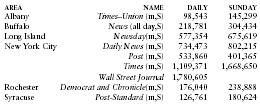New York
Press
A pioneer in the establishment of freedom of the press, New York is the leader of the US newspaper, magazine, and book-publishing industries. The first major test of press freedom in the colonies came in 1734, when a German-American printer, John Peter Zenger, was arrested on charges of sedition and libel. In his newspaper, the New-York Weekly Journal, Zenger had published articles criticizing the colonial governor of New York. Zenger's lawyer, Andrew Hamilton, argued that because the charges in the article were true, they could not be libelous. The jury's acceptance of this argument freed Zenger and established the right of the press to criticize those in power. Two late decisions involving a New York newspaper also struck blows for press freedom. In New York Times v. Sullivan (1964), the US Supreme Court ruled that a public official could not win a libel suit against a newspaper unless he could show that its statements about him were not only false but also malicious or in reckless disregard of the truth. In 1971, the New York Times was again involved in a landmark case when the federal government tried—and failed—to prevent the newspaper from publishing the Pentagon Papers, a collection of secret documents concerning the war in Vietnam.
All of New York City's major newspapers have claims to fame. The Times is the nation's "newspaper of record," excelling in the publication of speeches, press conferences, and government reports. It is widely circulated to US libraries and is often cited in research. In 2001, the Times Sunday edition was the number one Sunday newspaper in the nation, based on circulation figures. The New York Post, founded in 1801, is the oldest US newspaper published continuously without change of name. The Wall Street Journal, published Monday through Friday, is a truly national paper, presenting mostly business news in four regional editions. In 2001, the Wall Street Journal, the Times, the New York Daily News, the Long Island Newsday, and the Post were among the top ten largest daily newspapers in the nation. Many historic New York papers first merged and then—bearing compound names like the Herald-Tribune, Journal-American, and World-Telegram & Sun— died in the 1950s and 1960s. In 2001, the Syracuse Herald-American and Herald-Journal merged to form the Post-Standard
In 2002, New York had 35 morning newspapers, 24 evening papers, and 37 Sunday editions. The following table shows leading papers in New York, with their average daily and Sunday circulations in 2002:

| AREA | NAME | DAILY | SUNDAY |
| Albany | Times–Union (m,S) | 98,543 | 145,299 |
| Buffalo | News (all day,S) | 218,781 | 304,434 |
| Long Island | Newsday (m,S) | 577,354 | 675,619 |
| New York City | Daily News (m,S) | 734,473 | 802,215 |
| Post (m,S) | 533,860 | 401,365 | |
| Times (m,S) | 1,109,371 | 1,668,650 | |
| Wall Street Journal | 1,780,605 | ||
| Rochester | Democrat and Chronicle (m,S) | 176,040 | 238,888 |
| Syracuse | Post-Standard (m,S) | 126,761 | 180,624 |
There are two Spanish dailies published in New York City: El Diario La Prensa, with a circulation of 56,938 daily and 36,758 Sundays; and Hoy , with a circulation of 65,768 daily and 21,567 Sundays. The leading newspaper chain is the Gannett Co., Inc. (headquarters in Virginia). Other groups include Ogden Newspapers, Inc. (West Virginia), Hearst Newspapers (New York), and Johnson Newspaper Corp. (New York). All the major news agencies have offices in New York City, and the Associated Press has its headquarters there.
Many leading US magazines are published in New York City, including the newsmagazines Time and Newsweek, business journals like Fortune, Forbes, and Business Week, and hundreds of consumer and trade publications. Reader's Digest is published in Pleasantville. Two weeklies closely identified with New York are of more than local interest. While the New Yorker carries upto-date listings of cultural events and exhibitions in New York City, the excellence of its journalism, criticism, fiction, and cartoons has long made it a literary standard-bearer for the entire nation. New York magazine influenced the writing style and graphic design of the 1960s and set the pattern for a new wave of state and local magazines that avoided boosterism in favor of independent reporting and commentary. Another weekly, the Village Voice (actually a tabloid newspaper), became the prototype for a host of alternative or "underground" journals during the 1960s.
New York City is also the center of the nation's book-publishing industry. New York publishers include McGraw–Hill, Macmillan, Simon & Schuster, and Random House; many book publishers are subsidiaries of other companies.